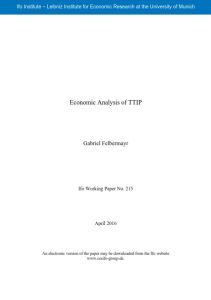Join getAbstract to access the summary!

Join getAbstract to access the summary!
Gabriel Felbermayr
Economic Analysis of TTIP
Ifo, 2016
What's inside?
Estimating potential gains from the Transatlantic Trade and Investment Partnership is a challenge.
Recommendation
The Transatlantic Trade and Investment Partnership (TTIP) could mean a more open economic environment between the European Union and the United States. TTIP’s potential gains would come from the reduction or removal of tariffs, the decreased costs of regulatory monitoring, and greater cooperation and productivity. However, various studies differ on the exact impacts of the trade deal on jobs and growth. In this report, economist Gabriel Felbermayr provides an in-depth look at the difficulties in measuring the future benefits or costs of this groundbreaking pact. getAbstract recommends this analysis to policy makers and executives.
Summary
About the Author
Gabriel Felbermayr is the director of the Ifo Center for International Economics.

















Comment on this summary